Why? Why? Why? Every preschooler’s favorite question. Annoying at times but important for building a knowledge foundation of how the world works – also key to how engineers, including structural engineers, approach new challenges and advance the profession. Rather than shutting down these questions, encourage problem-solving and creative thinking. Just as books for the youngest readers presented in Part 1 of this series of reviews introduced the language of engineering, several books aimed at preschool- to early elementary-aged children start to introduce engineering principles and approaches.
With the recent overall push to introduce STEM fields, including engineering, to younger children and especially young girls, there has been an influx of children’s books published on the subject in the last ten to fifteen years. Many particularly focus on female characters with encouraging “you can do anything” type messages. Older publications seem to be more male-dominated and take a “cool technology” approach. Ultimately, there is a place for all different types of stories, with both boys and girls pursuing their dreams, problem-solving, and being introduced to the tools and language of the field. It would also be good to see increased diversity in future publications as minorities are not well represented.
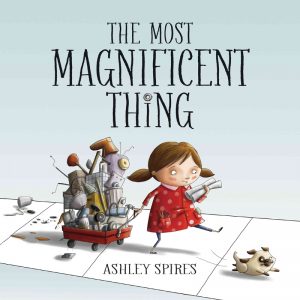
“When she is finished, she steps back to admire her work…. They are shocked to discover that the thing isn’t magnificent. Or good. It isn’t even kind-of-sort-of okay. It is all WRONG. The girl tosses it aside and gives it another go.”
The Most Magnificent Thing by Ashley Spires (Kids Can Press) explores the ideas of problem solving and perseverance in a spirited story of a little girl and her assistant (her dog) as they try to make The Most Magnificent Thing.
Despite knowing exactly what she wants to build, try after try. the little girl cannot get it right. She grows increasingly frustrated as her prototypes pile up until she finally must take a break and go for a walk. Coming back, she sees all her failed attempts and realizes that there are parts of each that she can use. Ultimately, she is able to make the magnificent thing! While the book does not use the language of engineering or call it out by name, the methodologies presented and the iterative design approach are core engineering principles. The “can-do” attitude of the little girl, along with her frustration when things do not go smoothly, are easy for kids to relate to and a good reminder to everyone that setbacks are a normal part of life, are not an indication that you are a failure, and do not need to end a project.
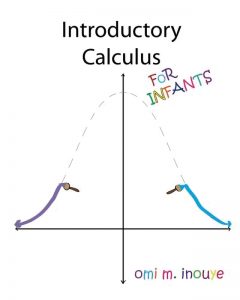
“You can be fun if you want to be! With me by your side you can be anything!
You can be Absolute! You can be Boundless!”
Introductory Calculus for Infants by Omi M. Inouye (omionline.ca) is an alphabet book telling the story of lonely x and fabulous f as they become friends. Despite the title, the language is beyond infants and best suited for the preschool crowd.
This book introduces 26 mathematical terms or concepts that form the basis of advanced math, including calculus, utilizing a minimalistic plot of building friendship as f(x) explores their possibilities. In much the same way the books for babies served to make the language of engineering familiar, this serves to establish the language of math, taking away the scary factor that comes from the unknown. There could be long-term positive impacts to engineering and STEM fields overall if the average high school senior was able to approach Calculus not as a scary, hard class reserved for nerds but instead as an approachable subject with a language they grew up with.
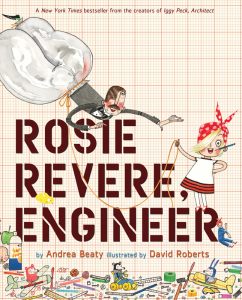
“But when no one saw her, she peeked in the trash for treasures to add to her engineer’s stash. And late, late at night, Rosie rolled up her sleeves and built in her hideaway under the eaves.”
Rosie Revere, Engineer by Andrea Beaty (Harry N. Abrams) is another story with a core message of perseverance and a “follow your dreams” approach aimed at young girls.
Rosie dreams of becoming a great engineer but hides her inventions away, afraid of failure and ridicule. Finally, her aunt sees her work and teaches her that failure is the first step to success. While engineering is the example used, the book is as much about believing in yourself and not worrying about what others think as it is about engineering. Rosie’s story holds the “girls can do anything” message at the forefront of the narrative, both through Rosie’s dream of becoming an engineer and through the aunt, also an engineer, who encourages her. The simple rhyming prose keeps the book to an appropriate level for preschoolers and helps hold their interest.
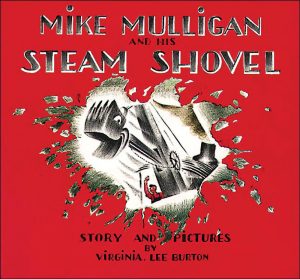
“When people used to stop and watch them, Mike Mulligan and Mary Anne used to dig a little faster and a little better.”
Mike Mulligan and His Steam Shovel by Virginia Lee Burton (HMH Books for Young Readers) is a classic story that has stood the test of time better than most. Mike Mulligan and his steam shovel Mary Anne have been involved in some great construction projects, but no one wants to hire them with new technology available.
Although an old-fashioned setting focused on friendship and hard work, Mike and Mary Anne still prove themselves useful and relatable. Engineering is more of a backdrop to the story here; however, the example projects that Mike Mulligan and Mary Anne worked on, referenced at the beginning, offer an excellent segway for side conversations and further discussion. Additionally, having a piece of equipment as the main character engages and teaches at the preschool level in much the same way it does for younger audiences. It is hard to know what bit of information will strike a child’s curiosity and lead them down the path to an engineering or construction career.
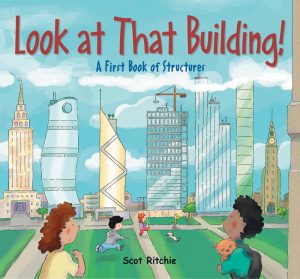
“Martin is watching the construction workers pour concrete. This foundation is going to be very strong. A foundation is the lowest part of a building. It keeps the rest of the building stable by anchoring it securely in the ground.”
Look at That Building! A First Book of Structures by Scot Ritchie (Kids Can Press) has a specific focus on structural engineering. Five friends wanting to build a doghouse head on a trip to the library for more information and observe the buildings they see on the way.
Far more technical and less of an engaging storyline than the other books discussed, the engineering concepts are front and center. Foundations, beams versus columns, framing, and even green roofs are introduced. This book will be more appropriate for the early elementary age range and for a child who has already shown some interest in these topics. Pull it out when you try to explain how to get that perfect Lego® tower to stand just a little bit taller.
The selection of engineering-themed books for preschool and early elementary ages is diverse in storyline and approach. Some use engineering in the background to tell a classic story of friendship or perseverance, and others put the language of engineering front and center. Since children in this age group will have stronger opinions on which stories they will listen to than babies will and come back to again and again, picking the best fit is more important. As previously discussed, the goal is to have engineering and technical concepts and language be enough a part of everyday life that it does not seem new or scary when they are older. The right book may just inspire a future engineer.■
